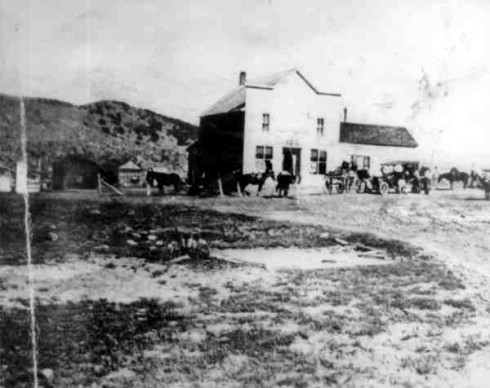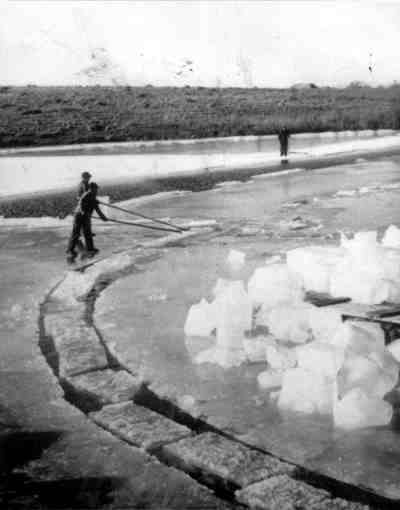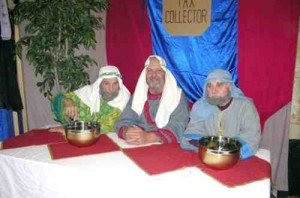Article by Don Simonton
Local History – December 2008 – Colorado Central Magazine
ANYONE INTERESTED IN A COMBINATION of beautiful scenery and interesting history should pay a visit to Hillside in the Wet Mountain Valley, ten miles south of Cotopaxi and Texas Creek. Perhaps you’ve never heard of it — and you’d better not blink or you’ll miss it — but it’s there, a cluster of nondescript buildings behind a simple sign.
The story of Hillside actually starts with the discovery of gold in California Gulch near modern Leadville in 1859. The miners there needed beef, and, since there was no way to bring it through the canyon of the Arkansas, the herds were either detoured through the rough country north of the river or up from the south.

In 1862 Joseph Lamb and Nat Rich drove fifty head of Texas steers up Copper Gulch into a wide place known as Trapper’s Park, and had them scattered by a mountain lion’s scream during the night. When they finally gathered them, they named the stream they’d camped on Texas Creek in honor of the origin of the herd. They then continued their drive across the heads of tributary canyons to the river. (Today’s town of Texas Creek, several miles downstream, was at that time known simply as a “ford” of the Arkansas). For obvious reasons, the country adjacent to this trail soon became devoted to cattle-raising.
The Witcher family came in to run thousands of animals on a mixture of private and public land that spread up from Hillside and across the Arkansas into five modern counties. Successful as he was with cattle, T Witcher (his name was Talliaferno, pronounced Tolliver, but was reduced to simply “T” ) didn’t do well with romance. His wife, Mary, preferred life in the city (Cañon City!) to life on the ranch. She bore him two sons, but refused to live with him in order to raise them. In desperation, T promised to build a house on the Wet Mountain Valley ranch and leave her there if she would just take care of the kids (it is believed this is the stone house still standing along County Road 198 above Hillside). But T finally had to hire a niece to raise the boys, while Mary went on to elope with a lover. She joined up with a gang of rustlers and train-robbers on the Arkansas, and, at one point, put out a contract on T’s life in order to collect his insurance.
Meanwhile, along the trail to Leadville, T Witcher had neighbors, homesteaders like Jasper Duckett, Ed Armstrong, Joe Lamb (namer of Texas Creek), and Seth Brown, all of whom established modest ranches on the impressive pastureland that sweeps down from the Sangre de Cristos to Texas Creek.
Jasper Duckett produced some classic yarns, like the one about a bear hunt where a wounded sow came after the hunters. One of Duckett’s sons shinnied up a small aspen, only to have it bend and lower him toward the bear. But then the bear went after Jasper, instead, and mauled his leg. Jasper was saved when another son broke his empty rifle over the bear’s head, but Jasper was somewhat crippled for the rest of his life. He’s buried in the Hillside cemetery.
A post office was opened for the neighborhood, and both Duckett and Armstrong were reported to have been early mail-handlers. But the most reliable record points to Laura (Mrs. Seth) Brown as the first designated “postmaster” in 1884; her ranch was named Hillside, and it therefore became the official Hillside post office, but it was located several miles north of the present site (on today’s Maytag Ranch), meaning the name doesn’t refer to any of the hills that are in Hillside now. The mail in those days was hauled to the railroad by stagecoach.

In 1894 Emma Hannah (Mrs. Marion) Beach became postmistress, and in 1896 the post office was moved to its present location on land the Beaches owned. A combination store/post office/residence was built, and in time it was joined by a community dance hall. A schoolhouse stood on the ridge between the original site and the new one; its water pump still stands beside the highway.
IN 1900, the railroad ran along Texas Creek, and special trains came from Westcliffe for popular dances. For $1.00 you could catch the train in town at 7:30 p.m., come up and dance (or just ” hear the music” ) until 2:30 a.m. (on a weeknight — and this during haying season?). Of course, as was so common in those days of wood stoves, everything — store, residence, and dance hall — burned to the ground periodically.
With the advent of railroad service, another industry entered the scene. Someone, reportedly around Buena Vista, had discovered that green leafy vegetables — especially lettuce — not only grew well at high altitudes, but were ready for market after the lowland veggies were harvested. So lots of the locals took to raising truck crops. During the winters they would cut ice from various ponds, store it in sawdust-insuIated buildings until summer, and then ice the refrigerator cars that hauled the produce to market.
Mining, which played such an important role in the early history of the Wet Mountain Valley that Silver Cliff was once a nominee for state capitol, was attempted above Hillside but never produced much more than what one old-timer described as “lots of experience.” However, it did produce some interesting by-products. In 1898 the Rito Alta (sic) mine opened with fanfare. When it failed in 1909, local rancher George Trout managed to tow the two-story commissary building all the way down the mountain to Hillside, where it became the principal structure for almost 100 years.
Another questionable mine that produced significant by-products was the Cloverdale, at timberline above Hillside. Attracted by W.B. Porch, the Oklahoman who opened the mine, investors from his state became interested in Hillside as a vacation spot. Porch accommodated them with his Rainbow Lake Club, a dude operation later sold to Edgar and Ruth Percival, who, in 1957, fell in love with the idea of their place becoming a youth camp and sold it to Lutherans, who developed it into the highly popular Rainbow Trail Lutheran Camp.
THROUGH THOSE YEARS, Billy Humble, the deaf-mute son of original Cloverdale investors, maintained the mine, with the help of his burro, and became so beloved of the Hillside community that County Road 198 was named as his memorial.
Meanwhile, the Beaches left the valley in 1909, but moved back eleven years later. By that time, almost all of the commercial operations had been moved into the larger Rito Alta building. In 1936 the Beaches’ daughter, Hattie, and her husband, Claude Eastman, took over and began an era of prosperity and popularity. They added a lunch counter, and Hattie became so famous for her pies that customers came from all over the region. Gasoline was supplied from pumps where the register was re-set with a hand crank. And, since not all of the ranches had telephones, Claude relayed messages to much of the neighborhood
Through the years, ranching has remained a viable industry in the area. A portion of T Witcher’s holdings is now the 4400-acre Trail’s End Ranch, well supervised and cared for. For a sampling of Witcher’s era, drive seven miles south to the mansion his neighbors, the Beckwiths, built; it’s now being restored as a museum, illustrating the style of the cattle barons. To the north, the homesteads around the original site of Hillside are now part of the Maytag Mountain Ranch, which offers select homesites along with partnerships in what will remain a 3000-acre working ranch.
Several families whose ancestors were colorful homesteaders still live nearby. The Kochs were among German colonists who came into the valley as part of a questionable promotion in the 1870s, and some of them survived busted dreams to put down roots. Their character is illustrated by Fred Koch. Legend has it, he once rode his horse into a Westcliffe bar, demanding a drink for himself and the horse, then shot the pipe out of the mouth of the bartender in order to be served. Nevertheless, Fred was described as a “hard-working, hard-riding, but likable old German,” typical of the neighborhood.
Neighbors to the Kochs, and by marriage relatives, have been the Berrys, originally from England. They could well be represented by Mollie Koch Berry, who was famous for her “turkey shoots.” She raffled off turkeys she’d raised with dice games, and the resulting affairs became the big social event of fall weekends, with elaborate refreshments served by relatives and friends.
SOMEHOW, Hillside survived all the changes that mining, ranching, hunting, truck-farming, and the years have presented. Perhaps the greatest threat to its existence occurred in the 1990s, when a wealthy Texan bought up both the town site and adjacent ranch, then announced great plans for its development. “We’re going to prune trees, plant shrubs, grass and flowers and convert Hillside into a show place.”
The Rito Alta store was to be torn down and replaced with a replica that would house a “stockman’s club.” There was to be an adjacent fancy horse-tack shop. These proposals got the owner involved in monumental conflicts with county officials and a majority of the locals.
One resident put it bluntly: “Wish he would have stayed in Texas…. We fought that man from the very minute he bought the store . . . He came to our town and he didn’t understand us.”
The upshot of all these promises and conflicts was the demolition of the historic store, a remodeling of the original Beach store as post office, the donation of a life-sized statue of a cowboy — “Doesn’t look like anybody that ever worked ranches around here” — and, ultimately, the auctioning off of the Texan’s Golden Meadows ranch, the town, and the “cowboy” statue. Happily, a group of locals created a partnership to buy Hillside, largely to preserve their post office.

Hillside, admittedly, has never been much more than its post office-store. It never had a mayor or a council. Today it occupies nine acres, some of which are inside a corral. Two of the old cabins are rented, and the would-be tack shop is now producing quality cabinets. In 1937 the Frémont County City Directory listed Hillside’s population as 117 families. If you stop — as you should — to visit the post office (hours are 7:00 a.m. to 2:00 p.m., with earlier closing on Saturdays), you’ll discover mailboxes collected from other obsolete post offices that are randomly arranged and number as high as 333. Actually, there are only 104 box holders, and postmistress Barb Koch, working from the back side, simply goes by names, not numbers.
In addition to the mailboxes, you’ll find some interesting historical photographs on the wall, plus an array of local arts and crafts. For an additional treat, walk behind the post office and absorb the magic of the grove of Western Black Willow trees planted by Claude Eastman around 1930. They’ve grown into a picturesque foreground for the Hillside Grange building, which was built in 1926 and is now on the National Register of Historic Places. Its stage features some classic backdrops, bordered by advertisements from Cañon City area businesses with 3-digit phone numbers.

So, if you don’t blink and miss it, but instead visit the post office/gift shop and cruise a bit of the neighborhood and meet a few of the friendly natives, I suspect you’ll find your trip to Hillside a very satisfying experience that blends scenery and history.
Don Simonton, a retired Lutheran minister who once served in Albuquerque, Santa Fé and Vail, is a Vail area historian and was the first director of the Rainbow Trail Lutheran Camp.


